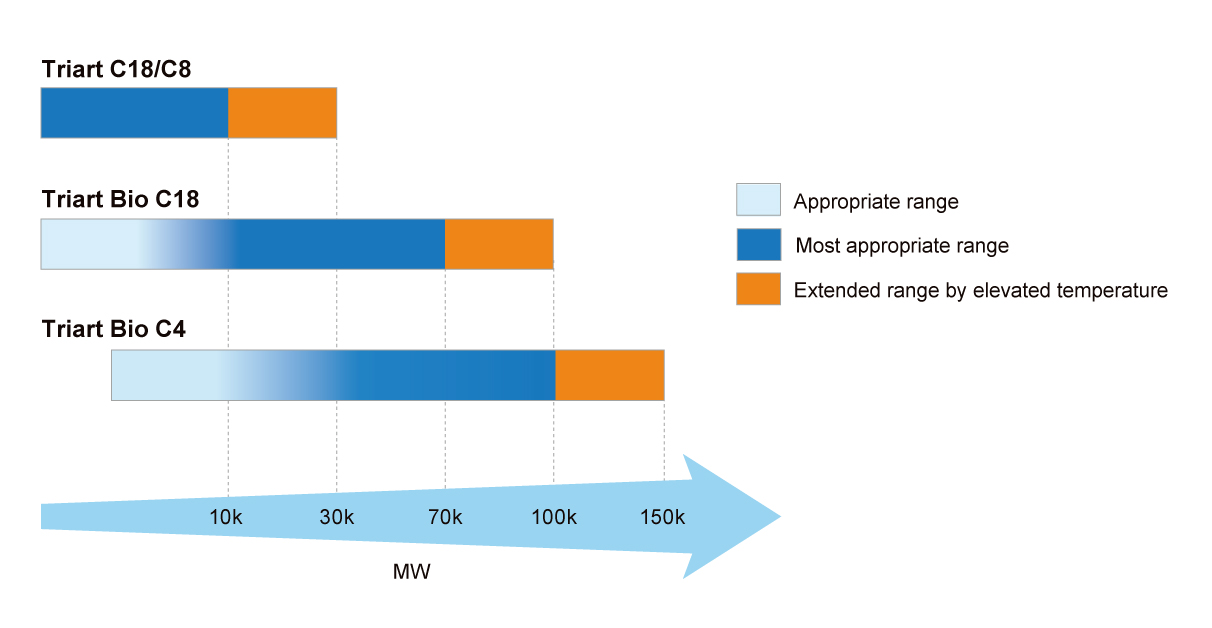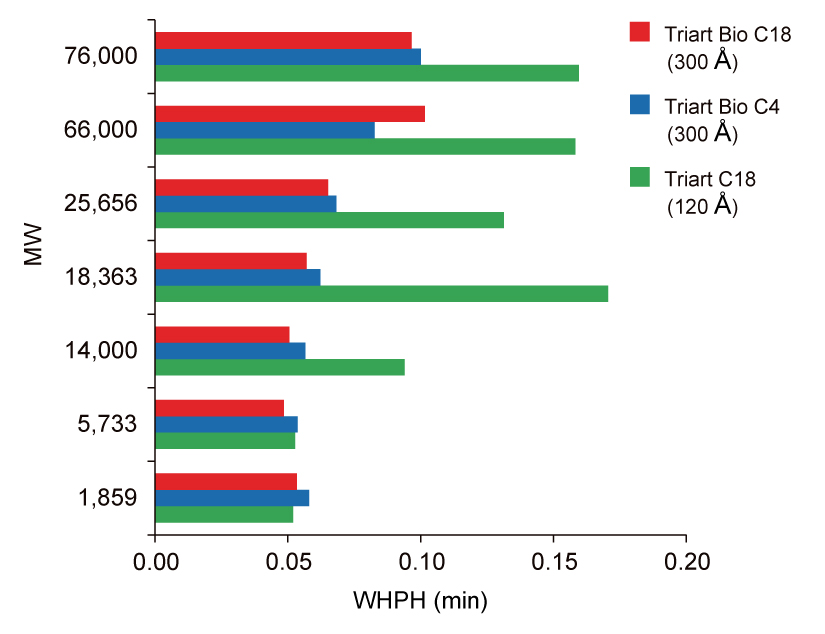| Column | Combination of functional group and the pore diameter |
|---|---|
| Mobile phase | Gradient elution with 0.1% TFA/acetonitrile system as first choice |
| Temperature | Effective for changing separation selectivity or improving peak shape. However, usable temperature range is limited by column durability. |
Columns are selected based on molecular weights (MW) of the target substances to separate proteins and peptides. The widths at half the peak height (WHPH) were compared when peptides and proteins with molecular weight (MW) from 1,859 to 76,000 were separated using Triart Bio C18 and Triart Bio C4 with pore size 300 Å, and Triart C18 with pore size 120 Å. Good peak shape was obtained using Triart Bio C18 and Triart Bio C4, which are wide-pore columns, even in separation of proteins with high MW. On the other hand, peak broadening was observed when using Triart C18 (120 Å) on separation of proteins with MW over 10,000. Wide-pore columns with pore size 300 Å are suitable for separation of proteins with MW over 10,000.


| Column | 150 X 3.0 mmI.D. |
|---|---|
| Eluent | A) water/TFA (100/0.1) B) acetonitrile/TFA (100/0.1) 10-95%B (0-15 min) |
| Flow rate | 0.4 mL/min |
| Temperature | 40°C |
| Detection | UV at 220 nm |
| Injection | 4 µL (0.1-0.5 mg/mL) |
| Sample | γ-Endorphin (MW 1,859), Insulin (MW 5,733), Lysozyme (MW 14,000), β-Lactoglobulin (MW 18,363), α-Chymotrypsinogen A (MW 25,656), BSA (MW 66,000), Conalbumin (MW 76,000) |
Increasing column temperature to 70°C provides selectivity change, sharper peaks, and therefore improved resolution especially for larger molecules.

| Column | YMC-Triart C18 (1.9 µm, 120 Å) 50 X 2.0 mmI.D. |
|---|---|
| Eluent | A) water/TFA (100/0.1) B) acetonitrile/TFA (100/0.1) 10-80%B (0-5 min) |
| Flow rate | 0.4 mL/min |
| Detection | UV at 220 nm |

| Column | YMC-Triart C18 (1.9 μm, 120 Å), 50 X 2.0 mmI.D. |
|---|---|
| Flow rate | 0.4 mL/min |
| Detection | UV at 220 nm |
Changing the column temperature will provide selectivity change as well as peak shape improvement. High durability column, Triart, can offer wider usable temperature range. Temperature can be used as a tool for method optimization.

| Eluent | A) water/TFA (100/0.1) B) acetonitrile/TFA (100/0.1) 25-45%B (0-5 min) |
|---|
Selectivity change can be expected by changing acid type and/or concentration. It is effective when there is a large difference in ionic characteristics of compounds.

| Eluent | A) acid-containing aqueous solution B) acid-containing acetonitrile solution (0.1% HCOOH in B solution is 0.08%) |
|---|---|
| Temperature | 70°C |
2-propanol is added in the mobile phase, and gradient slope is optimized. Resolution between peak 1 and 2 is improved while maintaining the analysis time.

| Eluent | A) 0.1% formic acid in water B) 0.08% formic acid in organic solvent |
|---|---|
| Temperature | 70°C |